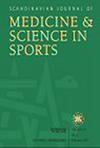个性化运动中情感体验的优化:视听刺激、运动强度和强度偏好的作用
IF 3.8
2区 医学
Q1 SPORT SCIENCES
引用次数: 0
摘要
在这项多研究调查中,我们研究了视听刺激、运动强度和强度偏好对急性运动中情绪效价的调节作用。我们还调查了缺乏运动的成年人在进行为期4周的视听辅助锻炼计划后的身体活动(PA)。在研究1中,参与者被随机分为视听组和对照组,并完成20分钟中等强度的跑步机跑步。在整个练习过程中评估情感效价。在研究2中,对高强度运动有高或低偏好的参与者完成了高于或低于通气阈值(VT)的两次运动。在每次运动中评估情感效价。在研究3中,对高强度运动有高或低偏好的参与者完成了为期4周的运动计划。参与者被随机分为两种强度条件:高于或低于VT。在为期4周的项目的最后阶段评估情感效价。在项目后1个月通过计步器评估未来PA。在研究1中,与对照条件相比,视听刺激导致了更多的积极情感效价。在研究2中,高偏好的参与者在低于VT的运动中比高于VT的运动中报告了更多的积极情感效价。在研究3中,运动强度和强度偏好之间的一致与4周时更积极的情感效价和更大的PA相关。这些发现强调了视听刺激和个性化强度在塑造运动期间情感体验中的作用。研究3特别表明,将运动强度与个人偏好相结合可以促进即时的情感收益和长期的PA坚持。本文章由计算机程序翻译,如有差异,请以英文原文为准。
Optimizing Affective Experience in Individualized Exercise: The Roles of Audiovisual Stimuli, Exercise Intensity, and Intensity Preference
In this multi‐study investigation, we examined the effects of audiovisual stimuli, exercise intensity, and intensity preference on modulating affective valence during acute exercise. We also investigated physical activity (PA) following a 4‐week audiovisual‐assisted exercise program among physically inactive adults. In Study 1, participants were randomized into audiovisual or control conditions and completed 20 min of moderate‐intensity treadmill running. Affective valence was assessed throughout the exercise. In Study 2, participants with high or low preferences for high‐intensity exercise completed two exercise sessions above and below the ventilatory threshold (VT). Affective valence was assessed throughout each exercise bout. In Study 3, participants with high or low preferences for high‐intensity exercise completed a 4‐week exercise program. Participants were randomized into two intensity conditions: above or below VT. Affective valence was assessed during the final session of the 4‐week program. Future PA was assessed via pedometers 1 month after the program. In Study 1, audiovisual stimuli led to more positive affective valence compared to the control condition. In Study 2, participants with high preferences reported more positive affective valence during exercise below VT compared to above VT. In Study 3, the alignment between exercise intensity and intensity preference was associated with both more positive affective valence and greater PA at 4‐weeks. These findings highlight the role of audiovisual stimuli and individualized intensity in shaping affective experiences during exercise. Study 3, in particular, demonstrates that aligning exercise intensity with personal preferences can foster both immediate affective benefits and long‐term PA adherence.
求助全文
通过发布文献求助,成功后即可免费获取论文全文。
去求助
来源期刊
CiteScore
7.90
自引率
4.90%
发文量
162
审稿时长
3 months
期刊介绍:
The Scandinavian Journal of Medicine & Science in Sports is a multidisciplinary journal published 12 times per year under the auspices of the Scandinavian Foundation of Medicine and Science in Sports.
It aims to publish high quality and impactful articles in the fields of orthopaedics, rehabilitation and sports medicine, exercise physiology and biochemistry, biomechanics and motor control, health and disease relating to sport, exercise and physical activity, as well as on the social and behavioural aspects of sport and exercise.

 求助内容:
求助内容: 应助结果提醒方式:
应助结果提醒方式:


